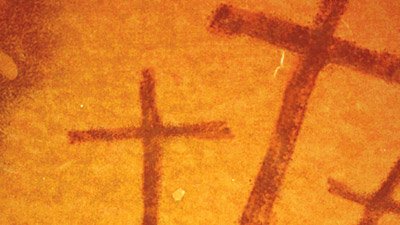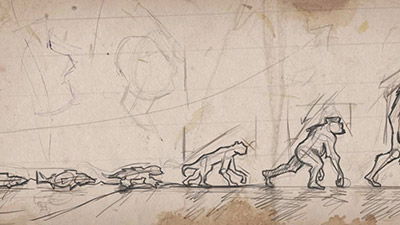Bye-Bye, Missing Link
Although first discovered in the early 1990s, the bones of Ardipithecus ramidus are only now being nominated for evolutionists’ fossil hall of fame—via a slew of papers in a special issue of the journal Science. In it, Ardi’s researchers describe the bones and make the case that Ardi is even more important in the history of human evolution than Lucy.
Despite claims of its evolutionary significance, one of the scientists who studied Ardi noted, “It’s not a chimp. It’s not a human.” That is, instead of looking like the hypothesized “missing link” (with both chimpanzee and human features), Ardi’s anatomy—as reconstructed by the scientists—shows it to have been distinct from other apes as well as from humans. The researchers have consequently shunned the notion of a missing link: “It shows that the last common ancestor [between humans and] chimps didn’t look like a chimp, or a human, or some funny thing in between,” explained Penn State University paleontologist Alan Walker (who was not part of the study).
The first question creationists have to answer is just what Ardi is. We can quickly eliminate important things that it isn’t: it’s not a human fossil, nor is it a complete fossil. In fact, even referring to “it” is deceptive, because Ardi is a badly damaged, incomplete skeleton put together with the help of a smattering of bones linked with at least 36 A. ramidus individuals. Dated at 4.4 million years old, the first bones were found in the early 1990s in Ethiopia. The delay in publishing an analysis was in part due to the poor state of the remains. “It took us many, many years to clean the bones in the National Museum of Ethiopia and then set about to restore this skeleton to its original dimensions and form; and then study it and compare it with all the other fossils that are known from Africa and elsewhere, as well as with the modern age,” said the University of California–Berkeley’s Tim White.
But the Evolution News & Views blog offered a more critical look at how the poor state of the fossils casts doubt on the scientists’ headline-grabbing claims. One telling quote comes from National Geographic News (in the same article that quoted Walker, linked above):
The first, fragmentary specimens of Ardipithecus were found at Aramis in 1992 and published in 1994. The skeleton announced today was discovered that same year and excavated with the bones of the other individuals over the next three field seasons. But it took 15 years before the research team could fully analyze and publish the skeleton, because the fossils were in such bad shape.
After Ardi died, her remains apparently were trampled down into mud by hippos and other passing herbivores. Millions of years later, erosion brought the badly crushed and distorted bones back to the surface.
They were so fragile they would turn to dust at a touch. To save the precious fragments, White and colleagues removed the fossils along with their surrounding rock. Then, in a lab in [Ethiopia], the researchers carefully tweaked out the bones from the rocky matrix using a needle under a microscope, proceeding “millimeter by submillimeter,” as the team puts it in Science. This process alone took several years.
Pieces of the crushed skull were then CT-scanned and digitally fit back together by Gen Suwa, a paleoanthropologist at the University of Tokyo.
Thus, as a starting point, creationists should remember that—as with many fossils—the state of preservation is far less perfect than what media images and “reconstructions” portray. (The “complete,” 4 feet [1.5 m] tall Ardi fossil, as reassembled, is shown on the cover of the special Science issue.)
We also know, as Walker explained (above), that Ardi actually shows many differences from both other apes and humans. Kent State University’s Owen Lovejoy described some of the features: “She has opposable great toes and she has a pelvis that allows her to negotiate tree branches rather well. So half of her life is spent in the trees; she would have nested in trees and occasionally fed in trees, but when she was on the ground she walked upright pretty close to how you and I walk.” Obviously, we would point out that the scientists haven’t actually observed Ardi walking; their assertion is based on their reconstruction of the bones. Furthermore, Ardi’s feet not only had opposable big toes, but also lacked arches, which separates Ardi from humans and means “she could not walk or run for long distances,” BBC News reports. And National Geographic News notes, “Ardi would have walked on her palms as she moved about in the trees—more like some primitive fossil apes than like chimps and gorillas.”
In fact, despite the headlines and hype, the evolutionary researchers aren’t even confident enough to say that Ardi is a human ancestor as opposed to simply an extinct ape. BBC News reports:
Even if it is not on the direct line to us, it offers new insights into how we evolved from the common ancestor we share with chimps, the team says.
Asked whether A. ramidus was our direct ancestor or not, the team said more fossils from different places and time periods were needed to answer the question.
“We will need many more fossil recoveries from the period of 3-5 million years ago to confidently answer that question in the future,” the scientists said in a briefing document that accompanied their journal papers.
“But if Ardipithecus ramidus was not actually the species directly ancestral to us, she must have been closely related to it, and would have been similar in appearance and adaptation.
Several scientists have admitted skepticism over the Ardi reports.
Not only does that uncertainty exist; several scientists have admitted skepticism over the Ardi reports. Harvard University paleoanthropologist David Pilbeam told ScienceNOW, “I find it hard to believe that the numerous similarities of chimps and gorillas evolved convergently.”1 (We, too, have criticized the idea of convergent evolution in the past—albeit from the opposite angle.)
Also, anatomist William Jungers of Stony Brook University criticizes the conclusion that Ardi could walk upright: “This is a fascinating skeleton, but based on what they present, the evidence for bipedality is limited at best. Divergent big toes are associated with grasping, and this has one of the most divergent big toes you can imagine. Why would an animal fully adapted to support its weight on its forelimbs in the trees elect to walk bipedally on the ground?” he told National Geographic News.
Finally, some scientists have asked how Ardi fits into the evolutionary scheme with Australopithecines like Lucy, another supposed human ancestor said to have lived more recently than Ardi. Was there enough time, in the evolutionary timetable, for primitive Ardi to have evolved into less-primitive Lucy? The BBC quotes Chris Stringer of London’s Natural History Museum, who said, “With Australopithecus starting from four million years ago, one would have thought that things would have moved further down the line by 4.4 million years ago. OK, you can have very rapid change, perhaps; or Ardipithecus might be a residual form, a relic of a somewhat older stage of evolution that had carried on. Perhaps we will find something more like Australopithecus at 4.4 million years old somewhere else in Africa.”
We must admit that from our perspective, we’re growing desensitized to the fervor that increasingly surrounds each new fossil discovery claimed to support evolution. Surrounding Ardi’s unveiling is a spectacular media frenzy, but in many ways it’s little different than the hype over Ida less than five months ago (see “Ida (Darwinius masillae): the Missing Link at Last?”). That hype was quickly revealed to be unmerited at best and dishonest at worst (see Ida (Darwinius masillae): the Real Story of this “Scientific Breakthrough”). In the same way, the concerted release of so many papers on Ardi and the corresponding hubbub seems to perhaps be more about attention-seeking than about science. Could it be that the ongoing pressure for scientists to find something of evolutionary “significance” has led to a systematic incentive to make a huge deal (to use the vernacular) out of otherwise trivial fossils?
Good science abstains from making such untestable, presupposition-driven claims.
Perhaps we’re being a bit too rough, though. Evolutionists believe our own origins lie buried in such fossils as Ardi, so it’s no wonder they have a desire to interpret such finds in the light of human evolution. But in the case of Ardi (and Ida, Lucy, etc.), good science abstains from making such untestable, presupposition-driven claims.
Given the number and scope of the papers presented this week on Ardi, it will take some time before creationists are confident in our conclusions on Ardi and her kin. Based on our first look, however, the facts seem solidly behind the idea that Ardi was a quadrupedal ape with relatively little in common with humans (i.e., no more than most apes); the key basis for the alleged Ardi–human link (which even the authors are hesitant to confirm) is the idea that it walked upright—an idea that even evolutionists have criticized. And we can’t forget that all of these conclusions are inferred from digital reconstructions and fallible reconstructions of bones that were in very bad shape.
Without having a live “Ardi” to observe, scientists will only ever be able to come to probabilistic conclusions about its characteristics. As far as we’re concerned, the evolutionary “threat” to creationists from Ardi is no more than that posed by Ida: viz., none.
Further Reading
For More Information: Get Answers
Remember, if you see a news story that might merit some attention, let us know about it! (Note: if the story originates from the Associated Press, FOX News, MSNBC, the New York Times, or another major national media outlet, we will most likely have already heard about it.) And thanks to all of our readers who have submitted great news tips to us. If you didn’t catch all the latest News to Know, why not take a look to see what you’ve missed?
(Please note that links will take you directly to the source. Answers in Genesis is not responsible for content on the websites to which we refer. For more information, please see our Privacy Policy.)
Footnotes
- Ann Gibbons, “Ancient Skeleton May Rewrite Earliest Chapter of Human Evolution,” Science, October 1, 2009, http://www.sciencemag.org/news/2009/10/ancient-skeleton-may-rewrite-earliest-chapter-human-evolution.
Recommended Resources

Answers in Genesis is an apologetics ministry, dedicated to helping Christians defend their faith and proclaim the good news of Jesus Christ.
- Customer Service 800.778.3390
- © 2024 Answers in Genesis






